Unsure about your French table manners? Click Here to download > > How to avoid these 10 food etiquette mistakes !
- Home ›
- Destinations ›
- Undiscovered France ›
- The Ideal Cheval Palace
Cheval Palace: How A Rural Postman Built His Dream By Hand
Published 9 February 2024 by Leyla Alyanak — Parisian by birth, Lyonnaise by adoption, historian by passion
Last week I visited the highly unusual Cheval Palace, built stone by stone by just one man – and it was a revelation. I loved the offbeat artistry, but I was especially taken by the vision and tenacity of a creator who had clearly never heard the word "impossible".
It took 10,000 days, 93,000 hours, and 33 years for one man to build his dream palace.
Walking into the garden that surrounds the hand-carved cement and mortar building, it’s hard to believe this is all the work of a single person: 23 meters (75ft) long and 12 meters (39ft) high, every nook and cranny painstakingly carved by hand by a self-taught artist with no architectural training whatsoever.
I had seen photos of this “palace” for years, but it wasn’t until recently that I actually looked it up on a map.
There it was, just under two hours’ drive from my home in eastern France. Finally, I hopped into my car and made the journey to one of the oddest structures I’ve ever seen in France.
And I fell instantly in love.
Le Palais Idéal du Facteur Cheval
The “Ideal Palace of the Postman Cheval” is not your everyday palace: it doesn’t really have rooms, and you cannot live in it.
What draws people here is the manifestation of a dream, a place unlike any other. If you're searching for the unusual or the offbeat, Cheval Palace is it.
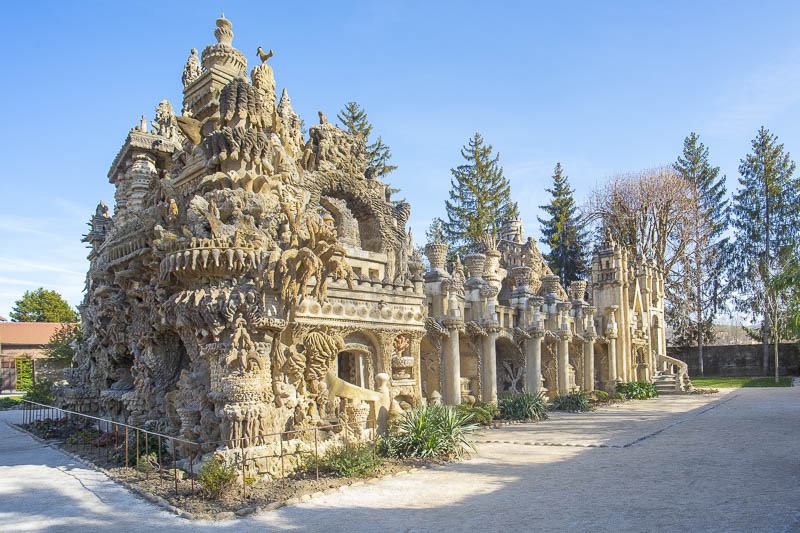
Its entire façade is sculpted, with everything from imaginary animals to mythological creatures, its architecture from every corner of the world, representing a variety of faiths, all decorated with philosophical sayings.
You’d think you were in Thailand. Or Egypt. Or Mexico.
All the work of a single man, Joseph Ferdinand Cheval, born in 1836, in an era of great upheaval.
The product of a poor family, his education was limited and after a stint in a bakery, he became a rural postman in his native Drôme, a beautiful French department that acts as a bridge between the Alps and Provence.
Everything changed in April 1879, when Mr Cheval tripped over a rock. He picked it up and noticed it was oddly shaped. So he took it home.
The next day on his rounds, he found another oddly shaped stone, even lovelier than the first. Coincidence?
“I kept finding better stones. I thought: nature wants to be a sculptor, so I’ll be the mason and the architect.”
From then on, the postman – whose daily route took him some 30 kilometers (18 miles) throughout the region each day – collected his stones, carving them and cementing them into his dream every evening after a hard day’s work.
His epic project would take him a lifetime.
The Palace
This little architectural jewel has four distinct sides, and you’ll first see the North facade, because it’s the one that greets you when you leave the ticket office. It doesn’t follow logic, however, because the North side was the last one to be carved.
As you face the North side, turn left and go around to the East side, continuing your visit in a clockwise direction.
The East side
His first work of art was a fountain, “The Source of Life”, flanked by a lion and a dog. Once that was built, there was no stopping him. Seashells, stones, mortar, he put everything into his building, adding waves and caves and temples.
A Hindu temple adorns one corner, along with the wheelbarrow he used to ferry his cement. An Egyptian tomb perches on another corner, designed as his burial place. Permission to be buried there would be refused, but more on that in a minute.
And then there are the three giants: Caesar, Archimedes and Vercingetorix, king of the Gauls.
This side took him the longest: some 20 years of his life to build.
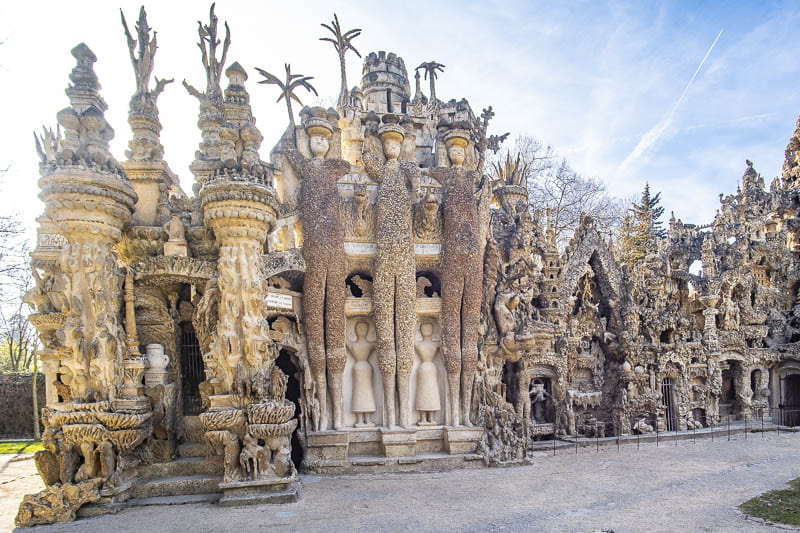
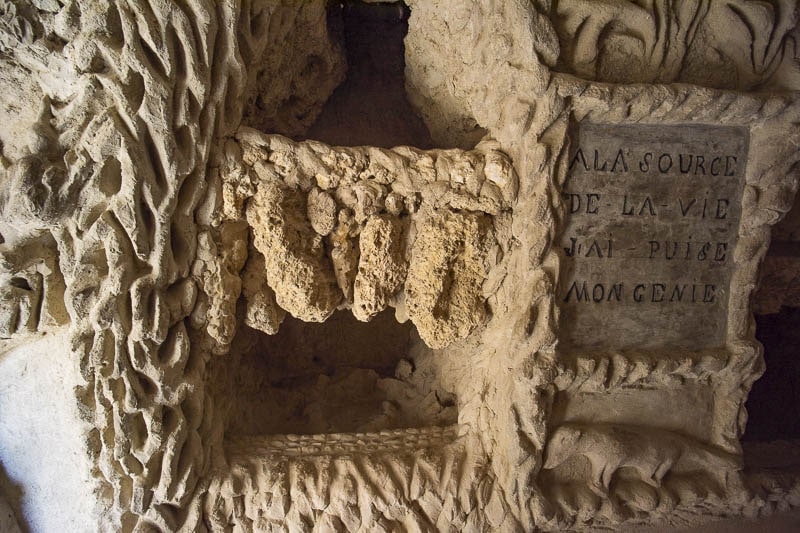 Top: the three giants. Bottom: part of the source - water once trickled through here but was stopped because it was eroding the building ©OffbeatFrance/Anne Sterck
Top: the three giants. Bottom: part of the source - water once trickled through here but was stopped because it was eroding the building ©OffbeatFrance/Anne SterckThe South side
I spent the least time here and have a more confused understanding of its message. Postman Cheval apparently placed his "Antedeluvian Museum" here, a cave in which he kept stones for future use.
I have to admit this is the one side I didn't "get".
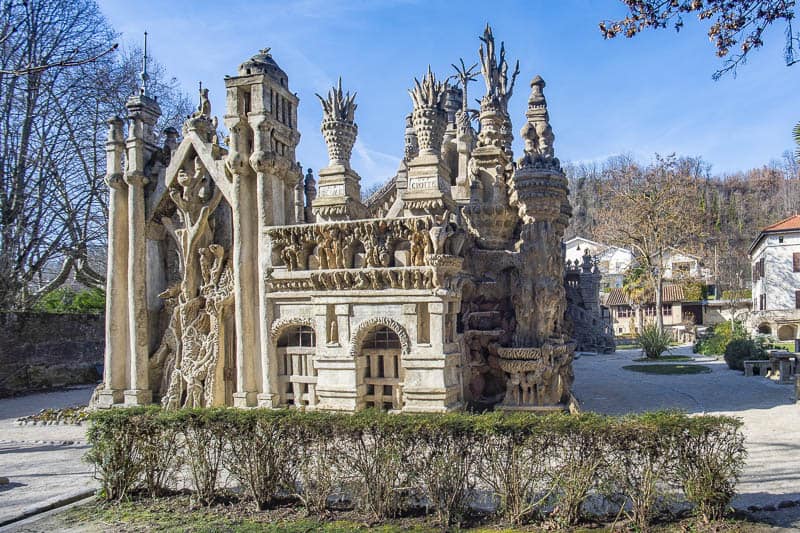 This view of the South side of the palace makes it seem a lot smaller than it actually is ©OffbeatFrance/Anne Sterck
This view of the South side of the palace makes it seem a lot smaller than it actually is ©OffbeatFrance/Anne SterckThe West side
This is perhaps the most intriguing side, with “architecture” from around the world – Cheval's vision of a Swiss chalet, of a medieval castle, and more (I don’t want to spoil it all for you).
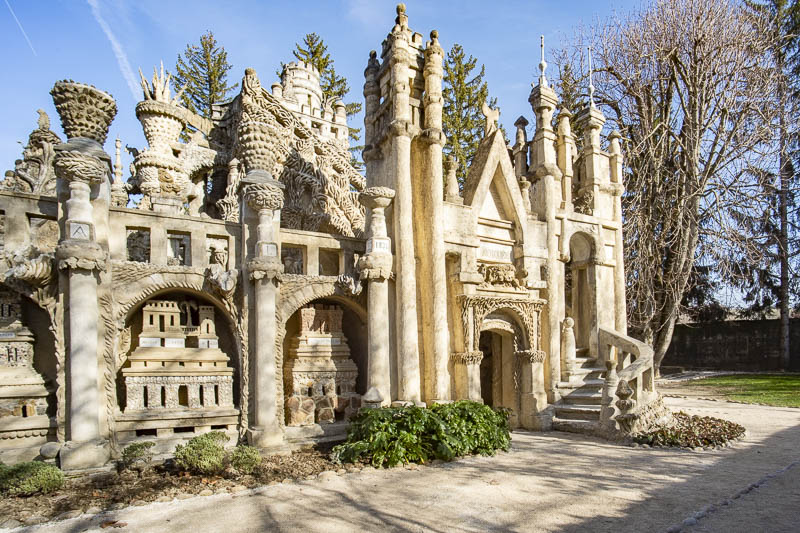
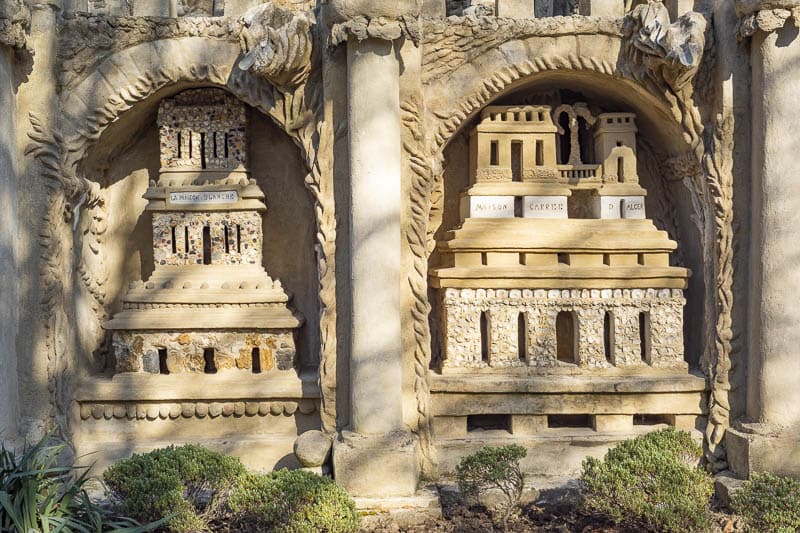 The West side of the Ideal Palace ©OffbeatFrance/Anne Sterck
The West side of the Ideal Palace ©OffbeatFrance/Anne SterckAn interior passage cuts lengthwise through the palace, filled with animal sculptures, and stairs lead up to the next landing because yes, the palace has two floors.
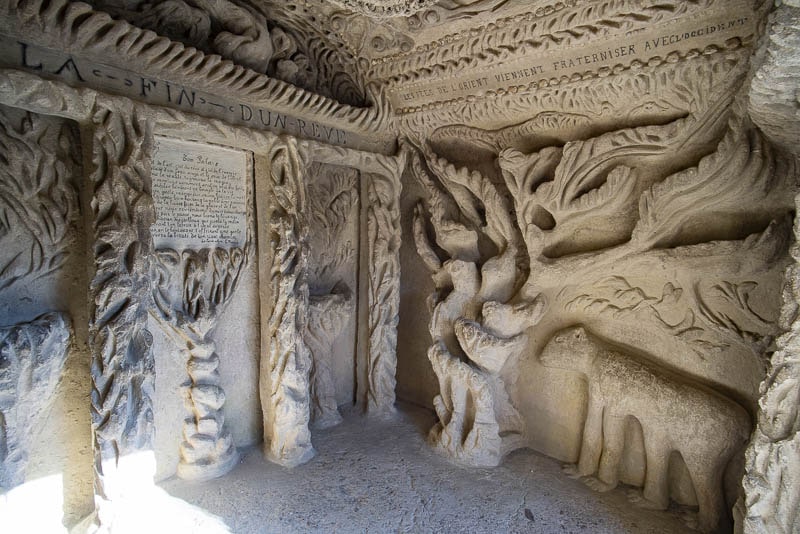
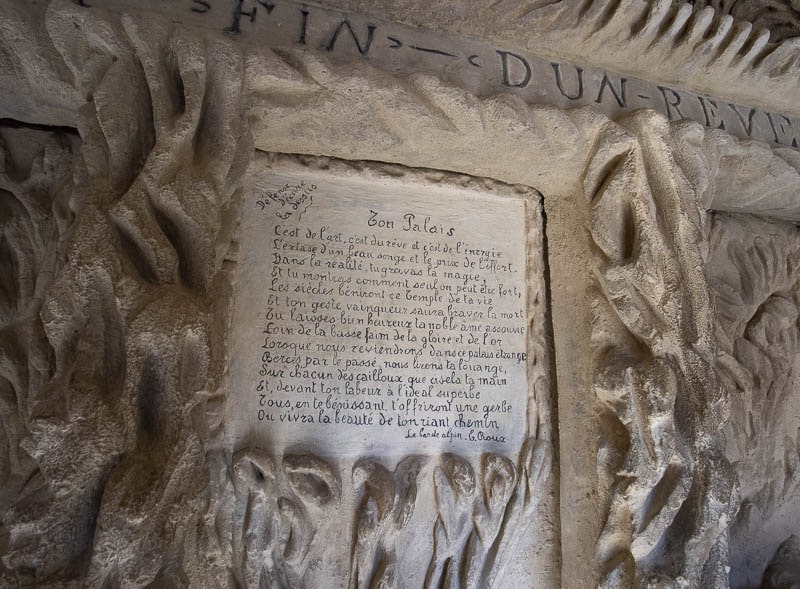
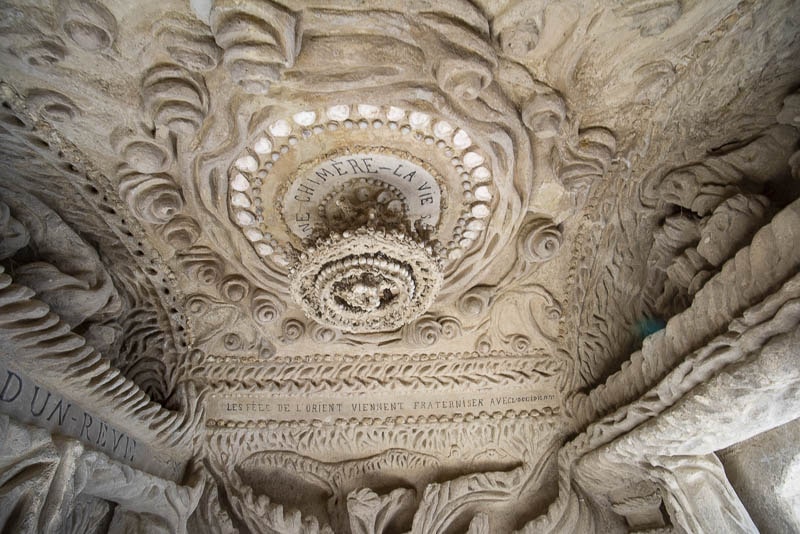
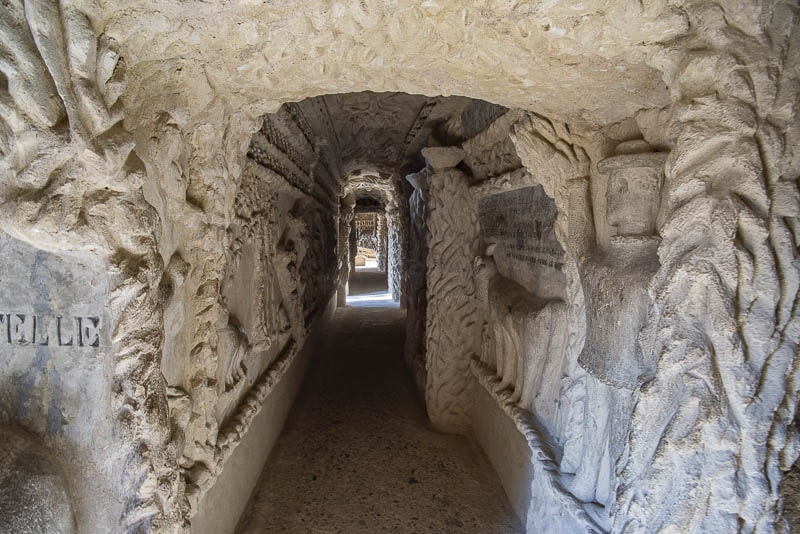 This is what the interior of the Ideal Palace of the Facteur Cheval looks like ©OffbeatFrance/Anne Sterck
This is what the interior of the Ideal Palace of the Facteur Cheval looks like ©OffbeatFrance/Anne SterckUpstairs is where you’ll find his first stone, the one that first caused him to trip, along with the original water tower which fed his first fountain.
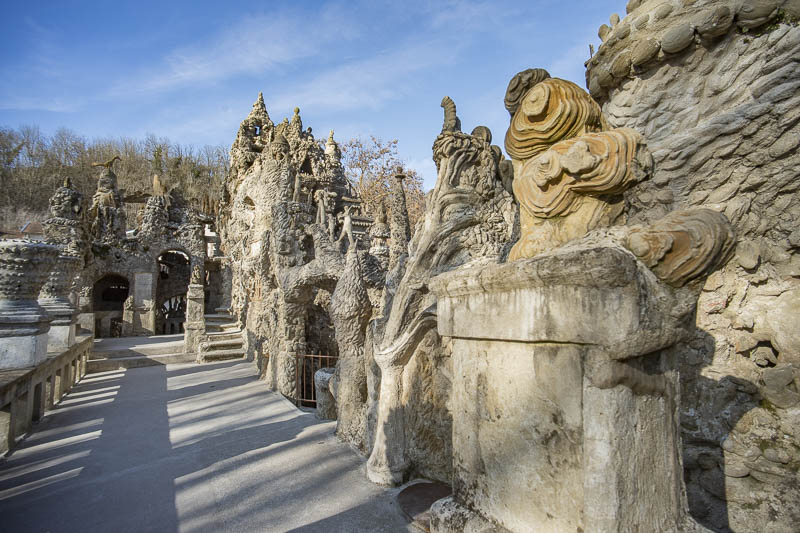 The strange-shaped stone that led to the palace's building ©OffbeatFrance/Anne Sterck
The strange-shaped stone that led to the palace's building ©OffbeatFrance/Anne SterckThe North side
This is the culmination of his work, and displays all the skill and knowledge Ferdinand Cheval gathered along the way, with grottoes and gargoyles and, finally, the octopus sitting on the western corner as his final carving.
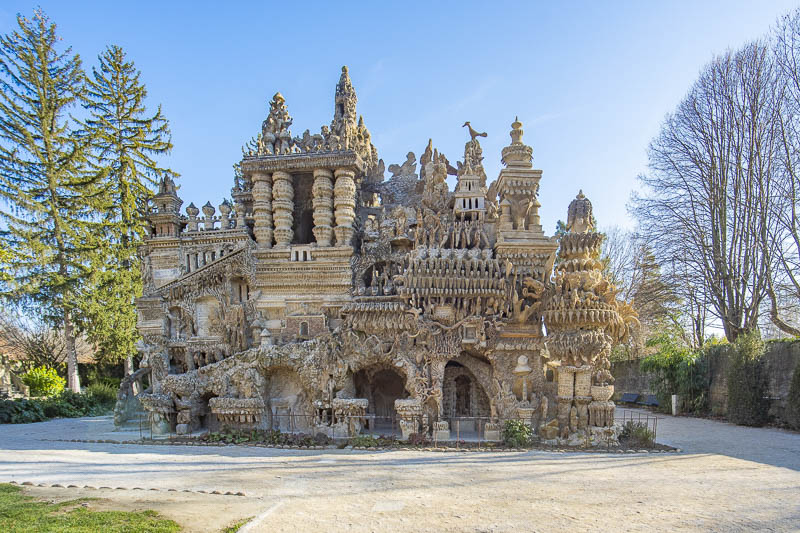
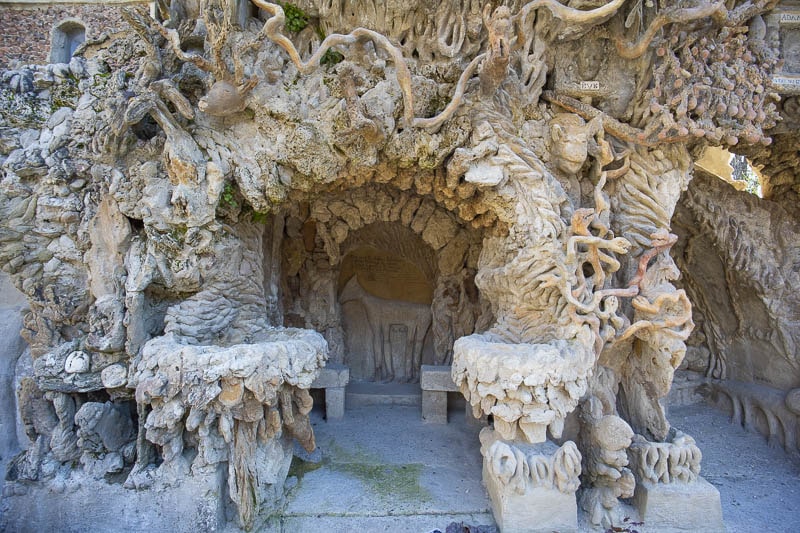
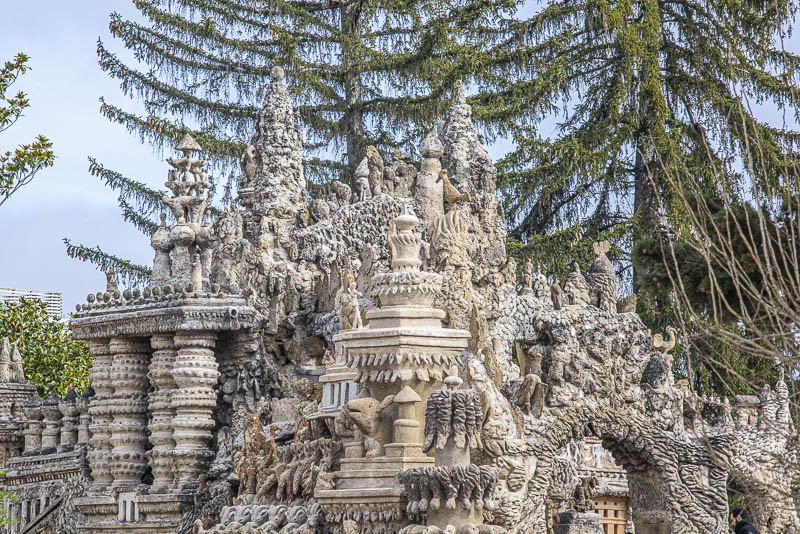 North side of the palace. Top: view from a distance. Middle: closeup of Eve with snakes. Bottom: a closeup of the octopus on the corner. ©OffbeatFrance/Anne Sterck
North side of the palace. Top: view from a distance. Middle: closeup of Eve with snakes. Bottom: a closeup of the octopus on the corner. ©OffbeatFrance/Anne SterckThe palace as art
A structure this unusual is bound to attract controversy.
As Postman Cheval amassed his materials, the townspeople considered him slightly crazy, the “man who fills his garden with stones”.
In fact, the town’s authorities took the case to court, complaining that the palace failed to respect building bylaws. A high court finally ruled it should be destroyed.
Many artists and experts concurred, calling this example of Outsider Art “hideous” and “repugnant”.
Then, in 1969, enter the Minister of Culture, author André Malraux, bucking popular opinion and earning the wrath of his own ministry in the process by declaring the Cheval Palace a Historical Monument, effectively protecting this cultural landmark from destruction.
Cheval Palace would live on.
However criticized initially, like many innovations, it grew on visitors over the years and slowly, opinions changed.
Surrealists and Art Brut artists threw their weight behind it: this was a special place. Such luminaries as Pablo Picasso and Max Ernst and Robert Doisneau would pay homage to the world’s only example of Naïve architecture.
When Cheval died, his daughters inherited the palace and sold their shares to… the same town that had wanted to destroy it.
The Tomb
I already mentioned his burial… You’d think that after 33 years of labor, his desire to be buried in his masterpiece might have been accepted. But no.
Like the town’s other citizens, he would be buried in the local cemetery, but his spectacular mausoleum – which took eight years to create – would outshine every other structure.
The cemetery is a two-minute drive from the palace and every bit as eclectic as his palace.
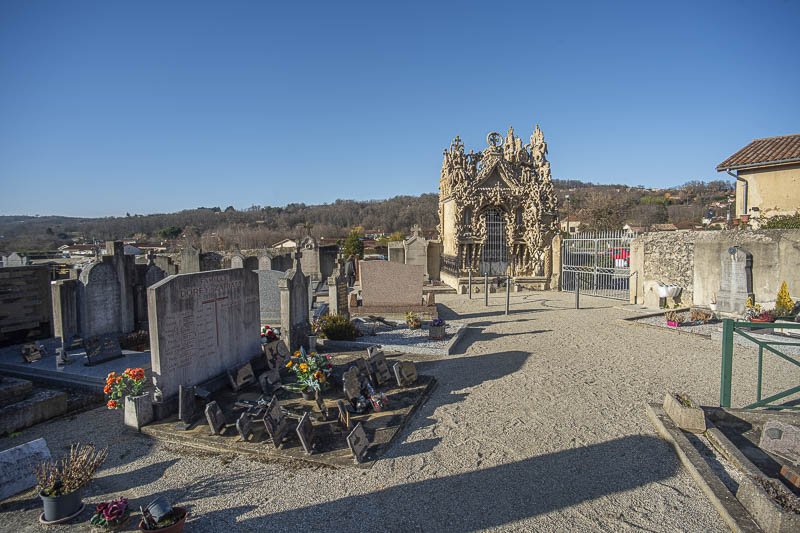
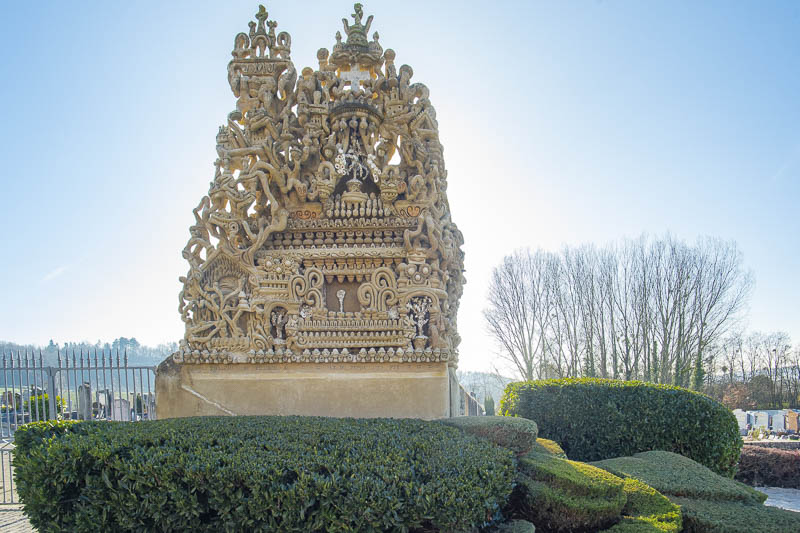
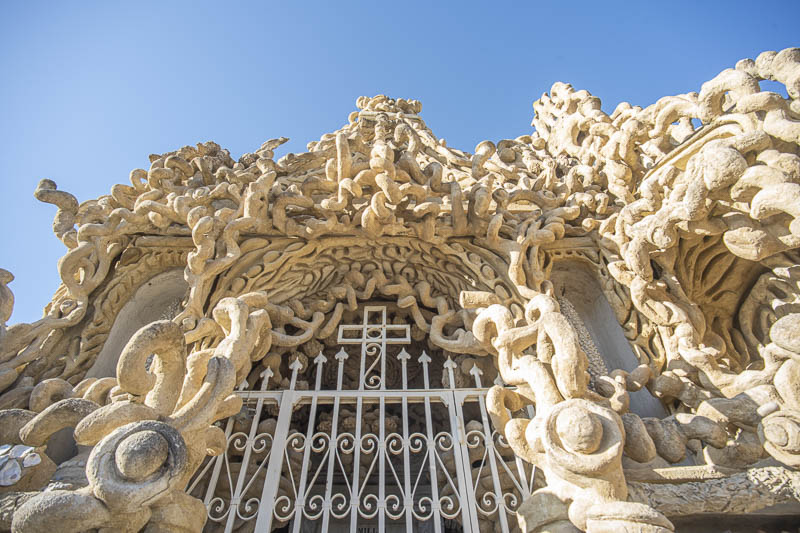 Set in an everyday rural French cemetery, Postman Cheval's mausoleum looks other-wordly ©OffbeatFrance/Anne Sterck
Set in an everyday rural French cemetery, Postman Cheval's mausoleum looks other-wordly ©OffbeatFrance/Anne SterckFrance’s favorite monument
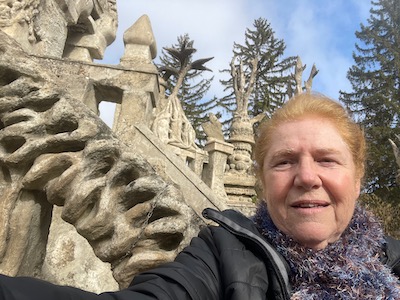 Me, at the Cheval Palace, perfecting the art of the selfie...
Me, at the Cheval Palace, perfecting the art of the selfie...Today, the Ideal Palace is one of France’s favorite sites.
Each year, voting takes place within a French television show called “France’s Favorite Monument,” presented by wildly popular historian Stephane Bern.
A bit like a game show, each French region presents its most unique monument, and people vote online for their favorite. The winners from each region then face off, with a final vote electing the best among the best.
Plenty of well-known monuments have been anointed in this way, from the fabled Place Stanislas in Nancy to the Eiffel Tower to the traboules of Lyon, so it’s not surprising that the Postman’s Palace should be on that elite list as well. In 2020, it came in at number 2 nationally, a major distinction.
The Ideal Palace is now a national attraction, with some 300,000 visitors each year. Not everyone loves it, but no one contests its right to stand tall.
Don’t miss the museum
Next to Cheval Palace is its small museum annex, with items relating to the French postman and some interesting exhibits of ancient postcards, a registry of visitors, and early sketches of the palace.
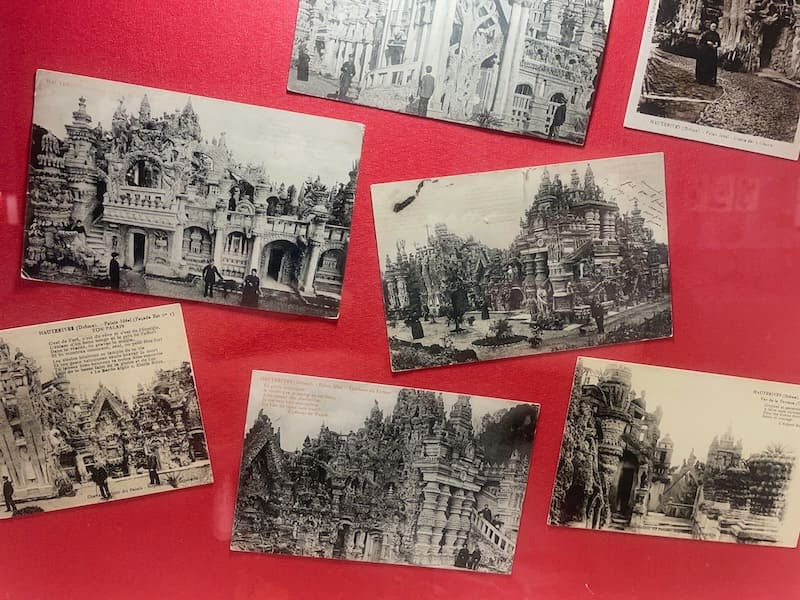 Historical items from the early days of the Ideal Palace ©OffbeatFrance/Leyla Alyanak
Historical items from the early days of the Ideal Palace ©OffbeatFrance/Leyla AlyanakFor an even greater in-depth look at the Palace, Google Arts and Culture has developed it even further.
Getting to Le Palais Idéal
If you’re driving, getting here is relatively simple. If you’re coming from Lyon, here’s a map to the destination.
Even if you don’t have your own car, you might consider renting one for the day if you happen to be in Lyon or Valence. Postman Cheval's Ideal Palace is located roughly between the two cities. You can check available rental cars and their price on this comparison site if you decide to rent for a day.
If you don’t have a car, it’s a bit more complicated. The Palace is located in the sleepy town of Hauterives, roughly between Lyon and Valence. You’d have to take a train to either Saint Vallier sur Rhône or Romans sur Isère. From these stations, it’s still a half hour bus ride to Hauterives (here are the official schedules).
Driving is a lot easier in this case, especially if you’re headed to the south of France – it’s a perfect stop along the way.
If you’re visiting in high season, make sure you book your ticket ahead of time, because the area is small and fills up quickly. It is open every day except Christmas and New Year’s, and closes each year during the second half of January.
Did you enjoy this article? I'd love if you shared it!

